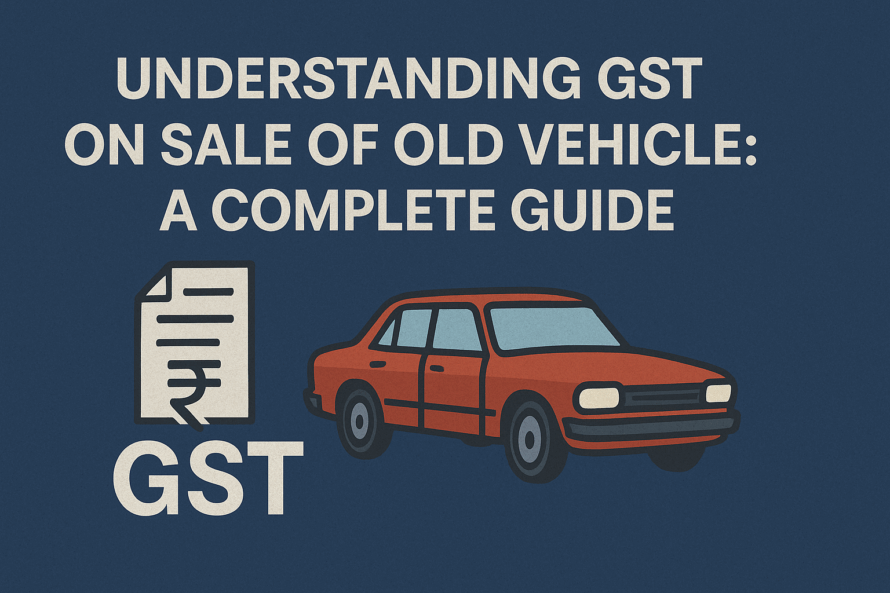
Prospective buyers often buy pre-owned cars as the cost of purchasing a new car is high, and the waiting period is long. However, most people who buy used cars from individuals or used car dealers are unaware of what the Goods and Services Tax (GST) law says about these purchases.
For example, there is uncertainty about which cars are subject to which GST rates. Who is impacted by GST on the sale of an old vehicle? Does GST apply solely to the dealer’s margin or the whole selling price? You, as the buyer, need to understand these points to determine the end price and make payments.
Overview of GST on the sale of old vehicles in India
However, GST on sale of old vehicle is applied differently from that on new cars. When you purchase a new car, the full price includes GST. For used cars, GST primarily follows the margin plan. The tax applies to the seller’s profit or margin from the sale, not the full sale price.
Definition and importance of GST in vehicle sales
The government recently changed the GST on used cars in India to a rate of 18% for all types of used vehicles. The GST Council announced this on December 21, 2024. The old GST rate ranged from 5% to 28%, depending on the type and age of the car.
Instead of taxing the full value of a vehicle, the new GST system taxes the profit margin that GST-registered sellers make when they sell used or old cars. This implies that only the margin, the difference between the purchase and sale prices, is subject to taxes, not the whole cost of the car.
Only companies or platforms registered under GST, such as auto dealerships and online marketplaces like Cars24 and Spinny, are subject to the increased GST on sale of old vehicle. Private deals between people, on the other hand, are still free from GST.
Historical context of GST rates on vehicles
The Indian GST on used cars has changed over time to make taxes easier and help the market for used vehicles. Let’s take a quick look at its history:
• Before GST
Before GST was implemented in July 2017, different states had their own taxes on the sale of used cars. This made things more complicated and inconsistent across various segments.
• After the Introduction of GST (July 2017)
The Goods and Services Tax (GST) raised the tax rates on used automobiles to the same levels as new cars, which were already higher than the state levies. This raised concerns about rising costs in the market for secondhand vehicles.
• Improvements in 2018
In January 2018, the GST Council changed the rates to ease concerns of automobile dealers. These were the new prices: Small and medium-sized used cars are subject to a 12% GST tax. Larger used cars, like SUVs, are subject to an 18% GST tax rate. Implementing a margin system allows GST to apply to the profit margin—the difference between the buy and sale prices—rather than the entire sale price.
• New Developments (December 2024)
The GST Council decided in December 2024 that all used cars sold by GST-registered sellers would be subject to the same 18% GST rate. This includes electric vehicles (EVs) as well. The change will make the tax system more uniform and easier to follow. Significantly, private sales between people will still not be subject to GST.
Calculating GST for old and used vehicles
Understanding the impact of the Goods and Services Tax (GST) is crucial when buying or selling old or used cars in India. The GST system for the sale of old vehicles is different from that for new cars. This reduces the burden of taxes, boosting the reselling market.
A step-by-step guide to GST calculation
Here is a guide on how to calculate GST for old and used cars to make things more straightforward:
Step 1: Choose the Vehicle Type
When it comes to GST, used cars fall into two main groups:
- Vehicles with engines that are up to 1200cc
- SUVs and other high-end cars with engines bigger than 1200cc
Step 2: Check Ownership and Registration
Taxes on used cars are handled differently depending on whether the seller is a licensed company or an individual:
- Dealer Registration: The margin scheme determines whether GST is applied.
- Unregistered Individual Seller: There is no GST payable if the individual seller is not a registered entity.
Step 3: Gain knowledge of the margin scheme
Registered dealers pay GST only on the margin, not the entire transaction price. Here’s how to figure out the margin:
- Selling Price – Purchasing Price = Margin
If the margin is negative, which means the car was sold for less than it was worth, there is no GST payable.
Step 4: Utilize the Relevant GST Rate
As per the latest directive from the GST Council, GST on all old and used vehicles is set at a uniform rate of 18%. The earlier rates ranged from 5% to 28%. This has simplified the tax structure for GST-registered dealers. However, private transactions between individuals are exempt from GST.
Step 5: Other Considerations
- Under the margin structure, secondhand cars are not eligible for the Input Tax Credit (ITC).
- The lower GST rates do not apply if the seller took advantage of ITC when buying the car.
Examples of GST calculations for different vehicle types
The market value of used cars was about 31 billion U.S. dollars in the fiscal year of 2023 and is estimated to increase to 70 billion dollars in 2028.
Listed below are some examples of GST calculations for different vehicles:
• Illustration 1: Small Hatchback Car (Petrol, <1200cc)
Purchase Price: ₹2,50,000
Selling Price: ₹3,00,000
Margin: ₹50,000
GST Rate Applied: 12%
GST Payable: (12 % of ₹50,000) ₹6,000
In this instance, because the dealer is registered and selling under the margin system, GST is only applied to the ₹50,000 margin.
• Illustration 2: SUV (Diesel, over 1500cc, over 4000mm Length)
Purchase Price: ₹8,00,000
Selling Price: ₹9,50,000
Margin: ₹1,50,000
GST Rate Applied: 18%
GST Payable: (18% of ₹1,50,000) ₹27,000
The higher GST charge of 18% is applicable because of the SUV’s characteristics. Again, GST is only applied at the margin.
• Illustration 3: Individual Sells to Individual
Purchase Price: Not Applicable
Selling Price: ₹5,00,000
There is no need to pay GST on this purchase since neither the vendor nor the buyer is registered as a dealer, and the trade is not considered a commercial transaction.
However, please note that since December 2024, the GST rate on the sale of all types of old vehicles has been standardized at 18%.
GST implications for sellers and buyers
The Goods and Services Tax (GST) significantly impacts purchasers and sellers regarding pricing, compliance with regulations, and earning input tax credits. If business transactions are to go smoothly, one must grasp what it stands for.
• Responsibilities of Sellers Under GST Regulations
Under India’s GST system, people selling used cars, especially registered dealers, must follow specific rules. When a licensed dealer sells a used vehicle, the taxpayer is responsible for GST. The GST is estimated using the margin plan. Only the profit margin—that is, the difference between the selling and purchase prices—is subject to GST under this structure, assuming no input tax credit (ITC) has previously been claimed.
In addition to maintaining accurate transaction records, sellers must provide accurate tax bills and apply the appropriate GST rate depending on the type of vehicle. For tax purposes, the car must be correctly classified. Furthermore, registered sellers must regularly submit GST returns and meet their billing and reporting duties.
In general, unregistered sellers and individuals are exempt from GST. Although businesses should strictly follow GST rules to avoid fines, they should also ensure they are reselling things legally.
What buyers need to know about GST on used vehicles
The change in taxes has a significant effect on the market for used cars:
- Reduced Price: The most obvious result is a significant fall in the cost of secondhand cars. Costs went up because of the old GST rates. Since these rates have decreased, buyers can now afford to buy used cars that were once too expensive.
- Uniform GST rate: Earlier, GST on selling old and used cars ranged from 5% to 28%, depending on factors like engine capacity. However, the GST Council has since introduced a uniform rate of 18% on the sale of old and used vehicles.
- Transparency and Efficient Transactions: The introduction of GST on used cars has clarified deals in the used car market. Standardized taxes have made things easier for buyers and sellers, leading to more accurate prices.
- Discounts and Dealer Margins: The new GST rules on used cars have helped sellers make more money. This has made it possible for sellers to give better deals to customers, which has improved the whole buying experience.
Conclusion
Understanding the GST on the sale of old vehicles is crucial for consumers and vendors. When you buy a used car, the Goods and Services Tax (GST) impacts the price and compliance. Buyers need to know the GST rates to make wise choices. Sellers, especially dealers, must follow GST rules to avoid fines.
People buying and selling used cars can now do so more easily since the GST rates have changed and the compensation cess has been removed. Making these changes to the tax system has made deals easier and given the market a feeling of balance and fairness.
FAQs
Q. Is GST applicable to the sale of all used vehicles?
If you buy a used car, you do have to pay GST. The rate changes depending on whether the seller is registered or not. However, there are some situations where the GST on the sale of an old vehicle by a registered person is only 18%.
Q. What is GST, and how does it apply to the sale of an old vehicle?
GST is only charged on selling used cars when there is a profit. That is, the price at which the vehicle is being sold is higher than its original cost, also known as its depreciated value. There is no GST if the margin is negative, which means the sale was at a loss.




